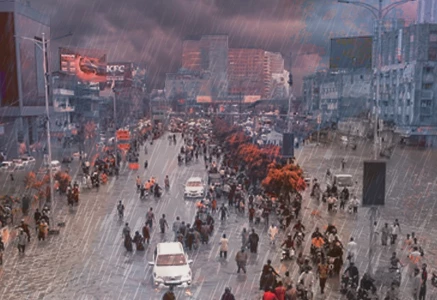A city that prides itself on daily resilience was brought to a complete standstill by the monsoon of August 2025. In less than 48 hours, torrential rain turned roads into rivers, intersections into lakes, and neighborhoods into isolated islands. Public holidays were declared, emergency services rushed into action, and residents tracked the storm until phone signals dropped and power lines collapsed.
By evening, officials reported rising casualties from drowning, electrocution, collapsing structures, and road accidents. The city received its heaviest rainfall since the late 1970s, while across Pakistan, flash floods in the north drove the national death toll into the hundreds.
A Widespread National Disaster
This was not Karachi’s tragedy alone. Monsoon rains also inundated southern Sindh, unleashed torrents in Khyber-Pakhtunkhwa and Gilgit-Baltistan, cut off highways, and forced large-scale rescue operations. The NDMA has warned of more heavy rain in Sindh, including Karachi, Hyderabad, Thatta, Badin, Mirpurkhas, and Sukkur, throughout the coming weeks.
Uneven Flooding Across Karachi
Flooding was not uniform across the city. Gulshan, Surjani, New Karachi, and parts of the northeast were submerged waist-deep, while other areas saw ankle-deep waters. Near Jinnah International Airport, gauges logged 163.5 mm — the highest since 1979 — while northeast Karachi recorded 178 mm, a five-year record. Other neighborhoods received between 80 and 145 mm, enough to overwhelm outdated drainage systems.
Environmentalists note that localised rainfall has become more common due to Karachi’s vast urban sprawl. “With expansion, rainfall differences are now more obvious — Malir may flood while other areas stay dry,” said Tofiq Pasha Mooraj.
Why Karachi Sinks Every Monsoon
Urban planner Farhan Anwar pointed out two main reasons:
- Lack of infrastructure: Unlike global megacities, Karachi lacks stormwater drainage systems, pumping stations, and emergency protocols. What should be temporary inconvenience becomes disaster.
- Encroached natural drains: Karachi’s natural drainage — the Lyari and Malir rivers, supported by Orangi and Gujjar nullahs — has been narrowed, blocked, or turned into dumping grounds. These were once the city’s defense, now reduced to open sewers.
A Century of Mismanagement
Karachi’s growth has obstructed natural drainage channels. Even when nullahs exist on maps, they are narrowed by silt, garbage, utilities, and encroachments, leaving no room for heavy flows. Municipal systems, designed for only 40 mm events, cannot withstand downpours exceeding 150 mm.
Thousands living along these nullahs add another dimension. Forced evictions without alternative housing push vulnerable communities further into risk. Experts argue that dignified relocation and affordable housing must accompany flood management.
Concrete, High-Rises, and Vanishing Green Spaces
Over the last three decades, unchecked urbanisation has replaced infiltration basins, trees, and open spaces with concrete plazas, roads, and towers. Runoff spikes quickly, creating instant flash floods. Karachi sheds water faster than it can absorb it, amplifying flood disasters.
READ MORE: Jazz Offers Free Calls in Flood-Hit Punjab to Support Relief Efforts
Structural Bottlenecks and Governance Failures
Undersized drains, choked inlets, and blocked outfalls repeatedly cause localized flooding. Efforts to widen sections of Gujjar and Orangi Nullahs helped temporarily but failed to address downstream choke points.
“Karachi’s crisis is not financial, it is political,” said Anwar, noting that after the 18th Amendment, provinces had funds but lacked governance and planning. The Karachi Metropolitan Corporation (KMC) has been reduced to paperwork, with no real authority over drainage, waste, or urban planning.
Lessons and the Way Forward
- Upgrade drainage standards to handle 21st-century rainfall extremes.
- Protect and restore natural drains like Lyari and Malir rivers.
- Invest in nature-based solutions: wetlands, bioswales, permeable pavements, and green roofs.
- Empower local councils and enforce accountability for failed agencies.
- Prioritize green spaces and floodplains in urban development.
“Extreme weather is no longer rare — it is the new normal,” warned Mooraj. Without urgent reforms, Karachi’s monsoons will shift from seasonal inconvenience to a permanent crisis.




